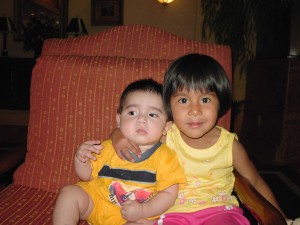I just hung up the phone from the U.S. State Department conference call on the status of Guatemalan adoption and I’m in awe of the composure of the other people who were on the line. Not the State Department employees, who are doing their best and are trained to remain composed. But the parents who have been waiting for their children for more than three years–the group known as the Guatemala900. How did those mothers and fathers not shriek with outraged fury–My child is growing up in an orphanage without me! My kid needs a loving family! Does anyone care about the fate of our children?
I’m afraid that’s what I might have done.
The first thing we were told was that the call was “off-the-record” for journalists. I doubt anyone considers my blog “journalism,” but in case they do, I’ll respect that caveat. Besides, there is little new to report since the 12/21/10 conference call. Guatemalan working groups continue to review cases. The universe of cases seems to remain around 385. The ones in PGN are staying in PGN; the ones in CNA aren’t moving from there, either. The pace is still slow. Excruciatingly so. Six cases per week, on average. At that rate, we’re looking at another year and a half to two years, minimum, for large-scale resolution.
I understand how important it is to remain positive. But the more I read articles, books, and other blogs about international adoption, the more I realize that emotion, and not reason, often seems to drive the decision-making process. Take adoption from Ethiopia. Recently, the government there announced that due to “irregularities”–real or perceived–only five cases a day would be processed. A spate of blog posts followed, pro and con, including an excellent overview at Creating a Family. In the Comments section, “abiye” wrote this:
“Most Ethiopians are not happy in what’s going on in the Adoption dram[a]. Ethiopians, particularly in Addis Ababa, get angry seeing white people coming into their country and leave with a child – as if that child is a pet. This is/was a talk of the town for last few years & the government knows it that at any time the anger can reach a boiling point.”
I posted in response:
“As an adoptive mother to two children from Guatemala, I admit there are problems in the system that must be fixed. However… From my observation, some of the controversy around international adoption stems from th[e] anger [abiye describes]. If that’s the case, perhaps no level of reform will ever be perceived as satisfactory.”
In a February 17 blog post, I wrote about the Kyrgyzstan 65, a group of adoptive parents in the U.S. whose pending adoptions have been hung up for years. Yesterday, March 30, an article titled Bishkek Lawmakers Reluctant to Lift International Adoption Freeze appeared on Eurasianet.org.
In 2008, responding to local rumors that foreigners were adopting babies to harvest their organs, the Kyrgyz government imposed a moratorium on international adoptions. Since then, American families… have been waiting to bring home 65 children whose adoptions were in progress when the freeze was announced. According to the Ministry of Social Protection, 30 of the 65 orphans have special health conditions and need regular treatment that is difficult to find in Kyrgyzstan. Two have died. Families in Kyrgyzstan have adopted only four.
Could it be that, around the world, unreasonable delays are happening because, bottom line, some people really don’t want these adoptions to be resolved? That, for reasons of their own, a nation would prefer their children live in orphanages than go to the United States? Recently, I was asked to participate on a panel about adoption from Guatemala. In preparation, the question arose about domestic adoption in Guatemala–that is, Guatemalan families adopting children who are not blood relations. How many such adoptions have occurred, now that adoptions are closed to outsiders? If an answer exists, none of us could find it, including a Guatemalan national with close ties to adoption. “Domestic adoption first” is held up as a solution, the better way to provide permanent families for children who need them. Wonderful. But in the three years since the December 2007 shutdown, few, if any, families in Guatemala have stepped up to adopt orphans.
Meanwhile, the families on the phone line today continue to wait.



 ShareThis
ShareThis



